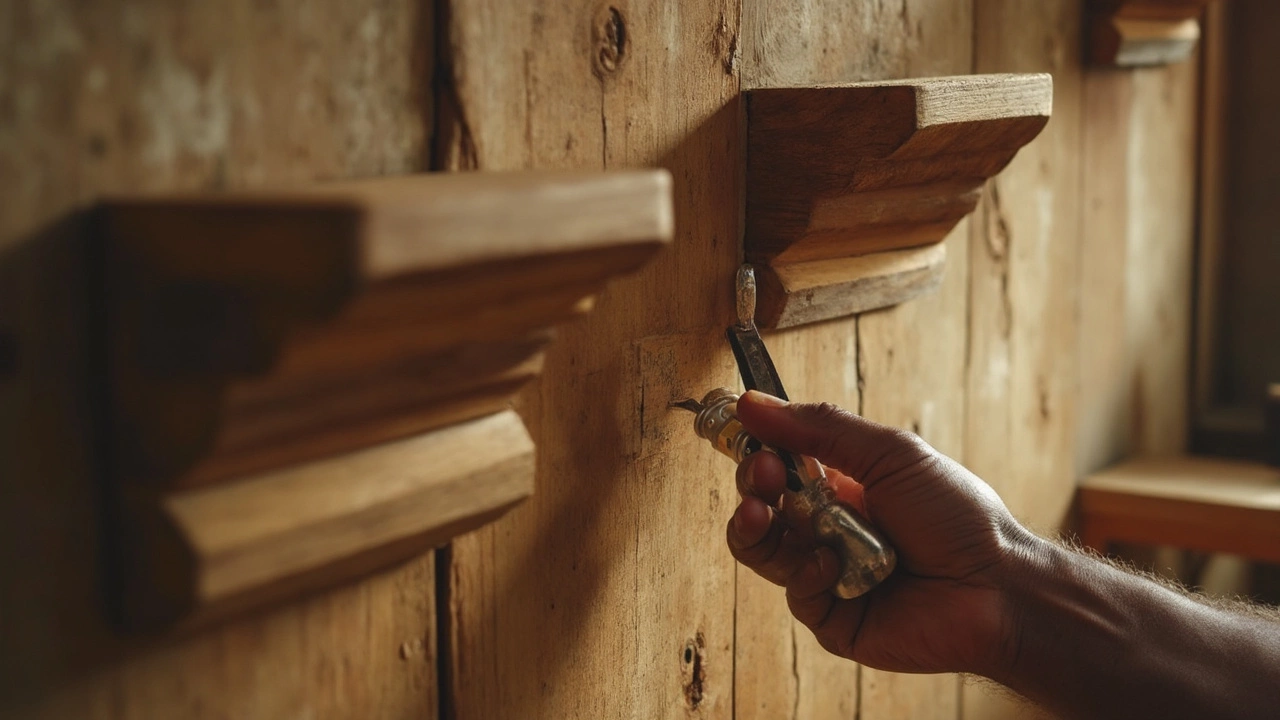If you've browsed home decor sites or even peeked at Instagram, you know floating shelves are everywhere. But when it comes down to money, do they actually save you cash compared to regular cabinets? It’s not a simple yes or no, but don’t worry—I’ve done the number crunching myself (and trust me, I looked at more receipts than I care to admit).
On the price tag alone, floating shelves usually cost less upfront. A basic shelf board, a couple of sturdy brackets, and you’re set. Cabinets, on the other hand, have doors, hardware, and more materials that really add up. But before you start taking down your upper kitchen cabinets and dreaming of open shelves, keep reading. There are hidden costs and value considerations you might not see at first glance.
Let's get into real-life pricing, where you can save, and where you might end up spending more down the line. If you’re deciding between floating shelves and cabinets—whether it’s for your kitchen, office, or living room—knowing these numbers now could spare you a lot of “oops” moments later.
- The True Cost: Shelves vs. Cabinets
- Installation: DIY Factor and Labor Bills
- Materials and Longevity—What Lasts?
- Getting the Most for Your Money
The True Cost: Shelves vs. Cabinets
When you compare floating shelves to cabinets, you might think shelves win hands-down on price. And for most small projects, that's true. A single floating shelf from a big-box store can cost anywhere from $15 to $60, depending on size and material. If you're looking at custom wood or designer options, it bumps higher, but basic shelves stay pretty wallet-friendly.
Cabinets take a bigger bite out of your budget. Even a stock upper kitchen cabinet usually runs between $100 and $300—just for one! If you want anything custom, prices can quickly hit $500 or way more per cabinet. Why so pricey? Cabinets use a lot more materials, plus hardware like hinges and handles, which all add up fast.
But the true story isn’t just the sticker price. You’ve got to consider how many shelves or cabinets you really need for your stuff. A cabinet hides more inside than a single shelf, and lets you stack and stash things out of sight. With shelves, you may need to buy more to hold the same amount—or live with things looking cluttered, which can drive some people nuts (ask Gareth; he can’t stand a messy shelf).
| Item | Average Cost (each) |
|---|---|
| Floating Shelf (basic) | $25–$60 |
| Wall Cabinet (stock) | $120–$250 |
| Custom Floating Shelf | $80–$200 |
| Custom Cabinet | $400+ |
There's another twist—don't forget about the extras. With shelves, you might fork out more for baskets, bins, or pretty boxes, especially if you don't love having everything out in the open. Cabinets save you there, since you can just shut the door on the mess.
So, if you’re talking about raw cost, floating shelves beat cabinets almost every time. But the right choice depends on the look you want, how you use your space, and, honestly, how much stuff you need to hide. The next step is looking deeper at what it costs to actually get them on your walls.
Installation: DIY Factor and Labor Bills
Here’s where the real gap shows up between floating shelves and cabinets: installing them. It’s a lot easier for a typical DIYer to slap up a few shelves than to mount full-blown cabinets on the wall. If you have a drill, level, and a stud finder, you’re honestly halfway there with shelves. Cabinets? Those guys are tricky. They’re heavier, way bulkier, and they really need to be anchored safely.
For folks handy with tools, a couple of floating shelves might take less than an hour. Most shelf sets have pretty simple instruction sheets. You can usually get by solo—no need to rope in all your friends for heavy lifting.
Cabinets usually demand two people and a chunk of your weekend. Not just because they’re heavier, but because lining them up so the doors aren’t crooked is oddly hard. Trust me, I’ve been there, and Gareth still teases me about our lopsided first try in the laundry room.
Paying someone for installation? Labor for cabinets almost always costs more. Contractors might charge anywhere from $50 to $200 per cabinet just for putting them up. Meanwhile, installation fees for standard floating shelves are often half that—or even less if you just pay a handyman for a quick visit.
| Storage Type | Average Labor Cost (per piece) |
|---|---|
| Floating Shelf | $30 - $80 |
| Cabinet | $50 - $200 |
One thing people forget: walls aren’t always perfectly flat. That’s not a huge deal with a shelf, but it’s a headache with cabinets. You might end up paying extra for adjustments.
- If you’re on a tight timeline or budget, shelves will get your project done faster, with fewer surprises.
- If you really want to go DIY, floating shelves are way more forgiving for newbies.
- But if you need the storing power of cabinets—say, for heavy dishware—sometimes spending on pro install is a smart call.

Materials and Longevity—What Lasts?
When choosing between floating shelves and cabinets, what they’re made of is a major deal-maker or breaker for your wallet and your peace of mind. Most floating shelves on the market use MDF (medium-density fiberboard), plywood, or solid wood. MDF is cheapest, but it can sag if you put heavy stuff on it. Plywood is a bit stronger, while solid wood costs more but can last for decades—if you treat it right. Some higher-end floating shelves mix in metal brackets or framing for extra strength, but you’ll pay for that durability.
Cabinets typically get built from plywood or solid wood as well, but these are thicker and structurally reinforced, especially if they’re supposed to hold dinnerware, appliances, or books. They’re also sealed to handle heat, moisture, and spills—stuff that open shelves can struggle with. Particleboard cabinets are cheaper but won’t last as long, especially in steamy kitchens or damp bathrooms.
How long do each really last? A decent quality floating shelf made of solid wood can hold up for 10-20 years with no issues, especially if you don’t overload it. MDF shelves might start sagging after a few years if they’re used for heavy items. Standard upper kitchen cabinets, on the other hand, often last 20-30 years or more before showing their age—assuming no major water leaks or disasters.
Here’s a side-by-side for a typical 36-inch shelf or cabinet (real numbers from home improvement stores as of early 2025):
| Material | Approx. Lifespan | Avg. Cost (per 36-inch unit) |
|---|---|---|
| MDF Floating Shelf | 5-10 years | $30-$60 |
| Solid Wood Floating Shelf | 10-20 years | $70-$150 |
| Plywood Cabinet | 20-30 years | $150-$300 |
| Solid Wood Cabinet | 30+ years | $250-$500 |
If you need storage that stands up to heavy use (think dishes, small appliances, or books), cabinets usually deliver more peace of mind. Floating shelves are great for lighter stuff, like photos, plants, or dishes you use every day. One last tip: whatever you choose, install everything into studs—not just drywall—if you want it to last.
Getting the Most for Your Money
When you’re comparing floating shelves and cabinets, you want to squeeze every bit of value out of your budget. Here’s where people usually slip up: getting stuck on the initial price without thinking about installation, upkeep, and long-term use. Let’s talk about how to make smart choices so your investment actually pays off.
Quality is king, no matter what you pick. Cheap pine shelves might warp fast, but spend a little more on solid wood or thick MDF and your shelving will go the distance. With cabinets, flimsy particle board won’t last like plywood or solid hardwood. You can sometimes get secondhand units for serious savings, or score basic floating shelves at places like IKEA for under $20 a pop, and even less if you’re handy and make them yourself.
Keep in mind, installation eats up cash, especially if you’re calling in a pro. Hanging floating shelves is usually cheaper and quicker to DIY, while cabinets often need two sets of hands—especially if you want them level and secure. If you’re not into power tools, floating shelves still tend to set you back less on labor fees.
Think about how you’ll use the storage, too. If you plan to pile up dishes or heavy stuff, cheap shelves might bend or pull out from the wall. Cabinets hide your clutter, which many people love, but open shelves push you to stay organized. Sometimes having fewer cabinets encourages you to keep only what you need, which is kind of nice for decluttering.
To stretch your dollars, try these tricks:
- Mix both styles—install floating shelves above a base cabinet. You get cheap display storage and hidden storage in one.
- Shop reclaimed or secondhand first. You’d be shocked how good some pre-loved shelves or cabinets can look with new paint.
- Look for adjustable shelving—paying a couple bucks extra can make your storage way more useful as your needs change.
- Add shelf brackets with style—sometimes the hardware makes shelves look ten times pricier.
Also, maintenance matters. Floating shelves mean you’ll be dusting more (the price of easy access), and if you splash a lot—think kitchens or bathrooms—consider water-resistant finishes. Painted cabinets tend to need touch-ups over time, especially around handles. So, add that into your mental budget.
Here’s a quick breakdown of common price ranges you might see out there:
| Storage Option | DIY Cost | Pro Install Cost |
|---|---|---|
| Basic Floating Shelf | $15 - $40 per shelf | $55 - $120 each |
| Wall Cabinet (24 inch) | $75 - $170 each | $200 - $400 each |
So, can floating shelves be cheaper? Absolutely, especially if you keep the install simple and don’t go wild on rare woods. But if you want sturdy, hidden storage, or plan to resell your home soon, cabinets might return more value. Stack your choices based on what matters most: price, looks, or staying organized. That’s how you really get the most for your money.
